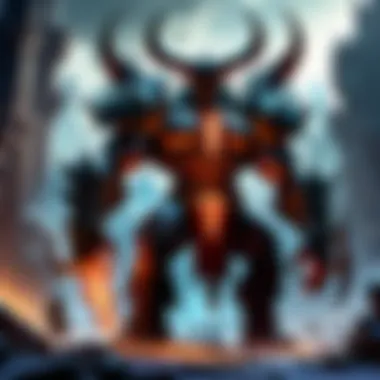Exploring the Top Mobile Games Inspired by Diablo


Intro
The realm of mobile gaming has evolved significantly in recent years, particularly for fans of action role-playing games (ARPGs). One of the most revered franchises in this genre is the Diablo series, known for its deep lore, engaging gameplay, and immersive environments. As smartphone technology enhances, many developers strive to capture the essence of Diablo in mobile titles, resulting in a growing selection of games that echo its signature mechanics and themes.
In this article, we aim to explore the best mobile games that reflect the core attributes of the Diablo experience. We will evaluate gameplay styles, thematic elements, and player experiences that align with the quintessential Diablo essence. Our goal is to provide a comprehensive overview, guiding audiences through the nuanced landscape of mobile ARPGs that can transport them into fantastical worlds filled with adventure and challenge.
We will delve into various aspects of these mobile games, including the mechanics that define them, community involvement, and overall player satisfaction. Whether you are an old-time Diablo veteran or a newcomer to ARPGs, this exploration seeks to enrich your understanding of mobile titles that can deliver memorable adventures while still drawing inspiration from Blizzard’s legendary franchise.
Intro to Diablo-Style Games
Diablo-style games hold a significant position in the realm of action role-playing games (ARPGs). They serve not only as entertainment but also as a means of immersive storytelling and strategic gameplay. This article explores the various facets of Diablo-style mobile games, focusing on their gameplay mechanics, visual appeal, and the community aspect. Understanding these elements better helps players appreciate the depth of these mobile experiences, particularly as they relate to the iconic Diablo series.
Overview of Action Role-Playing Games
Action role-playing games are a sub-genre of role-playing games that emphasize real-time action as a core element of gameplay. Unlike turn-based RPGs, where players take turns making moves, ARPGs involve continuous action, requiring quick reflexes and strategic thinking. Sometimes, players assume the role of characters battling through various challenges, often in a fantasy-themed world.
Diablo, first released by Blizzard Entertainment in 1996, revolutionized this genre. It introduced players to a dark, immersive universe filled with lore and character progression. Mobile adaptations of this formula capture the essence of these themes, making them accessible to a broader audience. With the rise of mobile gaming, ARPGs have seen a surge in popularity. Players now can engage in intense combat, loot collection, and skill-based progression, all from their mobile devices.
Characteristics of Diablo-Style Gameplay
Diablo-style gameplay is marked by several defining characteristics. The most notable include:
- Loot-Driven Experience: The thrill of discovering powerful items and equipment enhances player engagement. Loot affects gameplay by allowing players to customize their characters with various abilities and strengths, encouraging exploration and replayability.
- Character Customization: Players can choose and develop different classes, each offering unique skills and playstyles. Customization doesn’t only enrich the gaming experience; it also fosters a sense of ownership over one's character.
- Intense Combat: Fast-paced, hack-and-slash combat is a crucial element. Players face hordes of enemies and powerful bosses requiring tactical approaches and quick decision-making.
- Dark Atmosphere: The thematic tones often lean toward darker fantasy realms, similar to what players experienced in the console games. This atmosphere creates a strong emotional connection, drawing players into an extensive narrative woven throughout gameplay.
In summation, the realm of Diablo-style mobile games combines rich narratives, engaging mechanics, and the thrill of action-packed combat. Understanding these foundations opens the door to appreciating the allure of not just the Diablo series but also the many mobile adaptations that have sprung from its legacy.
The Evolution of Mobile Gaming
In the landscape of gaming, mobile gaming has witnessed a profound transformation over the past decade. The transition from rudimentary games to complex, immersive experiences has created a demand for games similar to the iconic Diablo series. This evolution holds significant relevance when considering Diablo-style mobile games. Mobile platforms are no longer just a supplementary space for casual games; they have become a robust environment for deep, engaging experiences.
Technological Advancements
As technology evolves, so do the capabilities of mobile devices. The advancements in hardware and software have made it possible to create games that previously were limited to console or PC platforms. The introduction of powerful processors, enhanced graphics capabilities, and online connectivity has allowed developers to replicate the intricate gameplay mechanics found in traditional action role-playing games.
For instance, the use of cloud gaming has revolutionized how gamers can access high-quality titles without needing high-end devices. This means that players can enjoy Diablo-like experiences on the go. Additionally, the rise of augmented reality (AR) has brought interactivity levels to new thresholds, allowing mobile games to offer engaging experiences that blend real-world elements with gameplay.
Shift in Player Demographics
The audience for mobile gaming has also shifted significantly. Gamers are no longer just teenagers or young adults. Today, the demographic spans various age groups, and interests are more diverse than ever before. This growing market includes casual players and dedicated gamers who seek deeply immersive experiences similar to those found in Diablo games.
- Casual Gamers: Often prefer shorter sessions, focusing on fun and simplicity. Companies catering to this segment must balance accessibility with engaging gameplay mechanics.
- Hardcore Gamers: This group seeks complexity and depth. They often look for detailed character development and extensive lore, paralleling the elements found in more demanding ARPGs.
Understanding these shifts is crucial for developers aiming to create successful mobile games that echo the engaging aspects of the Diablo series. The audience's needs directly influence game design and marketing strategies, emphasizing the necessity of adapting to meet varied preferences.
"Mobile gamers today are as diverse as the games they play. Recognizing this diversity helps in crafting experiences that resonate with players regardless of their gaming history."
Criteria for Selecting the Best Diablo-Style Mobile Games
Selecting the best Diablo-style mobile games involves a careful examination of various key elements. The Diablo series has set a high standard, and any game aspiring to emulate its success must meet certain criteria. Each of these criteria not only enhances the gaming experience but also ensures that the game fits within the action role-playing game (ARPG) genre in a meaningful way.
Gameplay Mechanics
Gameplay mechanics form the backbone of any successful game. In the context of Diablo-style games, this includes real-time combat, character customization, and loot acquisition systems.


Players should experience fast-paced action combined with strategic elements. A vital aspect is the diversity of skills and abilities that each character possesses. A well-designed skill tree can enhance replayability, giving players the option to experiment with different builds.
Furthermore, a good Diablo-style game should incorporate a range of difficulties. This ensures that casual players and hardcore enthusiasts alike find enjoyment and challenge in the gameplay. Intuitive controls are also critical, enabling players to engage in combat fluidly without unnecessary frustration.
Visual and Audio Design
Visual and audio design play a crucial role in immersing players in the game world. Graphics should not only be detailed but also reflect the dark, brooding aesthetic typical of Diablo games. Effective use of color palettes and lighting can greatly enhance the atmosphere. Designers should ensure that each environment feels distinct yet connected to the overarching lore.
Sound design is equally important. Immersive sound effects and a captivating soundtrack elevate the emotional impact of gameplay. This can include anything from the clashing of weapons to ambient noises in various environments. Clear feedback through sound cues when players perform actions or receive damage can significantly improve the game experience.
Community and Multiplayer Experience
The community and multiplayer experience in Diablo-style games cannot be overstated. Interaction among players adds a rich layer to the gaming environment. Engaging in cooperative play can mirror the experience of traditional console or PC gameplay, enhancing the social aspect of gaming.
Good games will have a robust online presence, with features such as leaderboards, community events, and guilds. These in-game communities foster camaraderie and competition, which can be central to a game's longevity.
Regular updates that reflect player feedback can further enhance community engagement. Developers should prioritize communication with players to create a responsive environment that adapts to the needs and desires of its user base.
Key Considerations: The ideal Diablo-style mobile game must balance gameplay mechanics, visual/audio design, and community elements to create a holistic experience that resonates with both new and veteran players.
Detailed Analysis of Top Titles
The analysis of individual titles is crucial in understanding the landscape of Diablo-style mobile games. Each title encapsulates distinct gameplay elements and community feedback which reflect broader trends in mobile gaming. By examining these elements, players can ascertain which games truly embody the essence of the Diablo experience. This analysis also allows developers to identify what works in the market, offering insights into player preferences and expectations. Consequently, a thorough examination of each game contributes significantly to the overarching discussions surrounding action role-playing games (ARPGs).
Game One: Title Review
Gameplay Overview
Gameplay is a key aspect of any game, and it is especially vital in Diablo-style titles where speed and strategy intertwine. The gameplay approach of the first game we review combines engaging mechanics such as enemy variety and skill customization. One standout feature is its atmosphere and pacing, which mirrors the frenetic intensity found in traditional Diablo games. This combination of engaging gameplay and player agency makes this game a popular choice among ARPG enthusiasts.
Monetization Model
The monetization model followed by this title highlights a balance between player enjoyment and revenue generation. It utilizes a free-to-play strategy, incorporating optional in-game purchases that do not detract heavily from player's experience. This approach enables a wide reach, allowing players to engage with the game without mandatory financial commitments. However, reliance on microtransactions can generate conversation among players regarding fairness and equity in gameplay.
Player Reception
Player reception is often a strong indicator of a game’s standing in the competitive landscape. The first game has garnered a favorable response, evidenced by player reviews across platforms. Communities discuss its immersive gameplay and consistent updates, which keeps engagement high. Nonetheless, some critiques point to instances of grinding, where players might feel progression can sometimes slow down, impacting enjoyment.
Game Two: Title Review
Gameplay Overview
The second game brings innovative mechanics that refresh traditional ARPG elements. A unique characteristic of its gameplay is the integration of cooperative multiplayer, allowing friends to join forces in real-time. This creates a dynamic environment where strategy and teamwork are essential to defeating tougher enemies. Players appreciate how this feature enhances the social aspect of the game experience.
Monetization Model
This game employs a battle pass model, which has gained popularity in recent years. Players can choose to invest in cosmetic upgrades and seasonal content through this model. While some find it beneficial as it keeps the game financially sustainable, there are discussions about how it can sometimes lead to a disparity in player capabilities based on investment.
Player Reception
The feedback for this title is largely positive, with players highlighting its engaging gameplay and community events. The sense of community is palpable, and ongoing developer support further strengthens player opinions. However, satisfaction can fluctuate based on the introduction of content, sparking discussions around the pacing of updates and events.
Game Three: Title Review


Gameplay Overview
The unique feature of gameplay in our third selection is the hybrid class system that allows for extensive character customization. This game provides players the ability to tailor attributes and abilities extensively, creating diverse strategies for combat. Players enjoy the depth this adds to gameplay, providing multiple paths to master their characters, making it a well-regarded option in the realm of mobile ARPGs.
Monetization Model
This title follows a one-time purchase model, which tends to attract a loyal player base that appreciates upfront cost clarity. Without the pressure of recurring monetary involvement, many players feel free to explore the game at their own pace. Nevertheless, this model can limit the game’s reach compared to free-to-play alternatives.
Player Reception
Player reception is strong for this title, with many citing its depth and lack of aggressive monetization as key benefits. However, it also attracts some critiques about potential lack of ongoing content updates which can lead to diminished engagement over time. Despite this, its loyal player base is vocal about their enjoyment of the core experience.
Game Four: Title Review
Gameplay Overview
The gameplay from this title is lauded for its engaging and immersive environments, creating a strong narrative link throughout quests and missions. The level of environmental interaction allows players to not only engage in combat but also explore and uncover story elements in each area. This unique strength enhances the overall narrative experience, allowing players to feel invested deeply in the storyline.
Monetization Model
This game uses an ad-supported model, giving players access to play for free while interspersing advertisements. While this can be advantageous as it lowers the barrier to entry, it often leads to mixed feelings among players who prefer uninterrupted gameplay. Some players appreciate the choice to view ads for in-game rewards, while others find it intrusive.
Player Reception
The reception has varied, with some players loving the storytelling and free access, while others express frustration with ad interruptions. The community largely engages in discussions about the pros and cons of this model. Overall, this title offers a blend of storytelling and gameplay that resonates well with a segment of ARPG fans.
Comparison of Key Features Across Games
In the vast landscape of mobile gaming, Diablo-style games represent a noteworthy segment, characterized by their specific gameplay elements and immersive narratives. Understanding the key features that differentiate these games is essential not just for player enjoyment, but also for assessing long-term engagement and community involvement. This section highlights core elements such as combat systems, character development, and environmental interaction, offering insights into how these components shape the player experience.
Combat Systems
Combat is central to the appeal of any action role-playing game (ARPG). In Diablo-style games, combat systems are refined and varied. These systems typically balance strategy, skill, and reflexes. A well-designed combat system often involves fast-paced action with many options for players to explore.
- Types of Combat: Games may offer melee or ranged combat, requiring different player tactics. Some titles feature combo systems, which enhance engagement and depth.
- Skill Tree Diversity: Players often have access to extensive skill trees, allowing for individualized combat experiences. This feature deepens players’ connections to their characters through tailored gameplay.
- Co-op Mechanics: Many Diablo-style mobile games introduce cooperative elements where players can team up. Shared strategies can result in more dynamic combat scenarios.
Ultimately, a compelling combat system not only keeps players entertained but also provides opportunities for research and refinement, addressing community feedback to improve gameplay.
Character Development
Character progression and development in Diablo-style games often defines the player's overall engagement. Unlike many mobile games, these ARPGs provide in-depth systems for growth and enhancement.
- Leveling Up: Players typically invest time in leveling their characters, unlocking new abilities, and expanding their combat styles. This adds a significant time commitment, often fostering a sense of accomplishment.
- Customization Options: Effective character development features robust customization. This could include equipment upgrades, attire choices, and skill selections that resonate with personal player styles.
- Narrative Ties: Character stories can intertwine with game lore, creating depth and encouraging emotional investment. Players become more attached to their avatars as they grow and face challenges.
These characteristics make character development pivotal in player retention and enjoyment, setting the stage for an enriched gaming experience.
Environmental Interaction
The game environment greatly influences player experience and enjoyment. Effective environmental interaction in mobile games contributes to a captivating gameplay experience.
- Interactive Elements: Many mobile games include breakable objects or hidden items within environments. Finding these elements offers rewards, driving exploration.
- Dynamic Environments: Weather changes, day/night cycles, and destructible terrain can significantly shift gameplay strategies. This adds layers of depth and realism, enhancing engagement.
- Immersive Lore: Well-designed environments often tell a story themselves. Environmental cues and lore contribute to a richer narrative, encouraging players to explore beyond just combat.
Incorporating thoughtful environmental interaction not only augments gameplay but reinforces the connection between players and the immersive world they inhabit.


Key Takeaway: Each game’s approach to combat systems, character development, and environmental interaction can vastly influence player experience. Understanding these factors is crucial for both current and future players seeking a deep, engaging mobile gaming experience.
The Role of Community in Mobile Gaming
Communities play a pivotal role in the success and sustainability of mobile games, especially those mimicking the Diablo series. The social aspect of gaming adds a layer of engagement that transcends mere gameplay. Players often form bonds, share strategies, and provide support, which enhances their overall experience. In Diablo-style games, where cooperative multiplayer is a common feature, the influence of community becomes even more pronounced. A thriving community can enhance a game's longevity and player retention. Without this social fabric, even the most technically sound games may struggle to find their footing.
Influence of Community Feedback
Community feedback serves as a critical component in shaping mobile games. Developers often rely on this input to refine and improve gameplay. Players may express their thoughts on game mechanics, balance issues, or desired features through various channels, influencing future updates. For example, a mismatch in difficulty can lead to frustration among players. When developers pay attention to this feedback, they can adjust gameplay to satisfy the community. This interaction fosters a sense of ownership among players, as they feel their voices impact the game's direction.
It is not uncommon for games like Diablo Immortal to incorporate suggestions made by the player base. This responsiveness assures players that their contributions matter, thus reinforcing their commitment to the game. Larger communities can even develop forums or polls to gauge the opinions of the majority, ensuring that changes meet the desires of most players.
Online Forums and Social Media Impact
Online forums and social media platforms are vital in mobilizing community support and discussions. Websites such as Reddit allow players to exchange tips, share experiences, and post inquiries about specific game elements. These platforms serve as an informal support system where players connect over shared interests, frustrations, and success stories within Diablo-style games. This connectivity often leads to the emergence of sub-communities that focus on different aspects of gaming, such as character builds, endgame strategies, or even lore discussions.
Social media, particularly platforms like Facebook or Twitter, facilitates rapid sharing of news and updates. Developers can engage directly with players through these outlets, providing a transparent line of communication. This real-time interaction helps forge a deeper bond between developers and players.
Moreover, these spaces promote the dissemination of fan-created content, such as art, videos, or guides, further enriching the community. Gamers who contribute creative works often receive accolades from their peers. This positive reinforcement enhances the overall gaming culture around Diablo-style titles.
"The community's voice can make or break the success of a mobile game, acting as both a motivator for developers and a social glue for players."
In summary, the role of community in mobile gaming cannot be overstated. Community feedback and online interactions shape the player experience, influencing both game development and player satisfaction. The significance of a united, engaged community is evident across successful mobile games in the Diablo genre.
Future Trends in Diablo-Style Mobile Games
The mobile gaming landscape is changing rapidly. This section will discuss future trends in Diablo-Style mobile games. Embracing innovation is vital for the longevity and quality of these games. Game developers will likely explore several key areas.
Emerging Technologies
Next-generation technologies are primed to impact Diablo-style mobile games. One of the most significant advances is augmented reality (AR). Games implementing AR can create immersive environments that blend gameplay with the real world. Players can interact with both virtual monsters and their actual surroundings.
In addition, cloud gaming will become more prevalent. This enables players to stream high-quality games without needing powerful hardware. They can play on various devices. This makes Diablo-style experiences more accessible.
Machine learning may also influence game design. Developers can analyze player behavior to adjust difficulty and personalize experiences. This approach can keep players engaged by providing unique challenges tailored to their preferences.
"The integration of emerging technologies could redefine the landscape of mobile ARPGs and enhance player engagements exponentially."
Sustainability of Mobile Gaming Trends
Sustainability is a critical consideration for the future of mobile gaming. As more players engage with Diablo-style games, it is important to focus on ethical development. This includes fair monetization practices. Players expect transparency regarding in-game purchases. Developers need to focus on earning revenue while also respecting player trust.
Another important aspect is community-driven content. Games that allow players to contribute ideas or modifications tend to foster more robust communities. This interaction can lead to richer experiences for all players. It also strengthens loyalty, ensuring that the community remains active and vibrant.
Finally, the integration of green gaming principles is gaining traction. Developers are exploring ways to reduce carbon footprints. This can range from choosing energy-efficient server solutions to optimizing code. Sustainable practices can create a responsible industry standard, appealing to eco-conscious consumers.
Epilogue
The conclusion section encapsulates the significant findings laid out in this article regarding the world of Diablo-style mobile games. Understanding this landscape is invaluable for gamers seeking new experiences that resonate with the essence of Blizzard’s classic franchise. The allure of these games lies not only in their gameplay mechanics but also in their ability to create immersive narratives and vibrant communities.
Recap of Key Insights
In reviewing the highlights of this article, a number of key insights emerge:
- Gameplay Mechanics: Diablo-style mobile games feature core mechanics such as fast-paced action, character customization, and loot systems that keep players engaged.
- Visual and Audio Design: Quality graphics and sound design play vital roles in enhancing the gaming experience, paralleling what players expect from top-tier titles.
- Community and Multiplayer Experience: These games foster community interaction through online forums and social media, allowing players to connect and share strategies, thus enriching the overall gaming experience.
- Emerging Technologies: Technologies such as augmented reality and cloud gaming may redefine how players experience ARPGs on mobile platforms in the future.
Final Thoughts on Future Developments
As we look ahead, the future of Diablo-style mobile games will likely be shaped by continuous advancements in technology and shifting player preferences. The integration of artificial intelligence and more sophisticated gaming engines could lead to richer narratives and player experiences. Additionally, maintaining a balance between monetization strategies and player satisfaction will be critical for the longevity of these games.
The community aspect remains crucial in this evolution. Developers who pay attention to player feedback and engagement are more likely to create successful titles. To conclude, the journey into the realm of Diablo-style mobile games promises to be exciting. Keeping an eye on trends and community sentiments will be essential for both players and developers alike.



